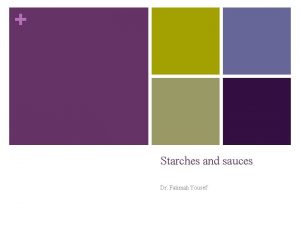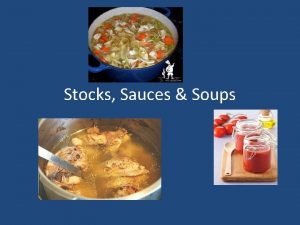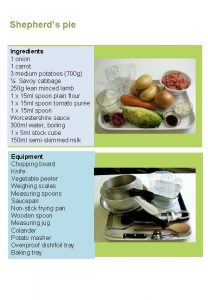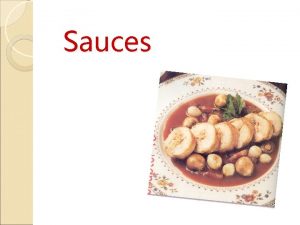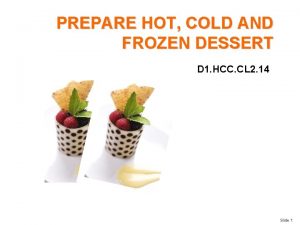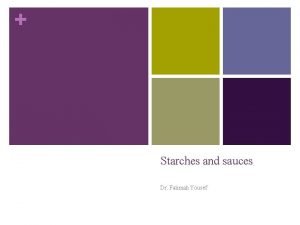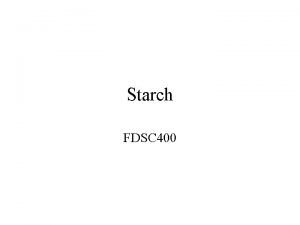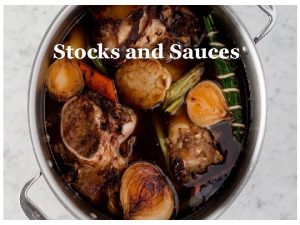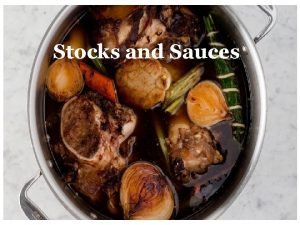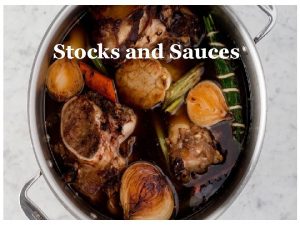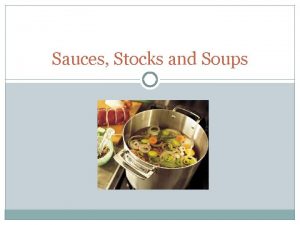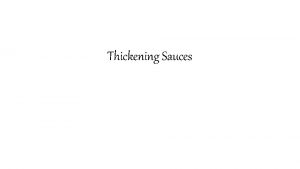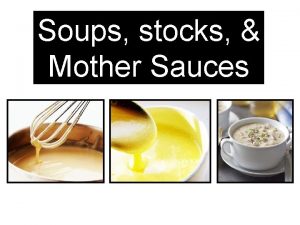Starches and sauces Dr Fatimah Yousef n Starch




















- Slides: 20

+ Starches and sauces Dr. Fatimah Yousef

+ n Starch: Starch are made up of glucose molecules synthesized by plants through the process of photosynthesis. n The glucose is converted to starch by the plant, and then utilized for energy or stored in the seeds, stem, or tube. n The size and shape of the granule is characteristic of the plant from which it came and serves as a way of identifying the source of a particular starch. n The structure of the granule of grain is crystalline. Dr. Fatimah Youaef 12013

+ Sources of starch The most common sources of starch: n Potatoes. n Cereals. n Bread. n Pasta. n Rice . Dr. Fatimah Youaef 12013

+ Starch in food products Starch serves several purpose in the food industry including its use as: n Thickening or gelling agent. n Edible films: Starch films are used as a protective coating for chewing gums, to bind foods such as meat products…. n Sweetener source. Dr. Fatimah Youaef 12013

+ Thickening agent n Starch's main use in processed foods is as a thickening and/or gelling agent. n Foods that are frequently thickened with starch include soups, sauces, pie, filling, gravies, creamstyle corn. Dr. Fatimah Youaef 12013

+Starch structure n Two general types of starch exist: n Amylose. n Amylopectin. n Different plants have different relative amounts of amylose and amylopectin. These different give each starch its characteristic properties in cooking and gel formation. n Most starch contain more amylopectin (75 %) than amylose (25%). n Varying amylose content causes texture differences in starch-containing foods. n There are some starches, such as waxy corn starch, which contain only amylopectin. Dr. Fatimah Youaef 12013

+ Amylose n It contribute to gel formation. This is because the linear chains can orient parallel to each other, moving close enough together to bond. Amylopectin n The branched amylopectin molecules give viscosity to the cooked paste. This is partially due to the role it serves in maintaining the swollen granule. Dr. Fatimah Youaef 12013

+ Starch characteristics: Starches have the capacity to go through the processed of: n Gelatinization. n Gel formation. n Retrogradation . n Dextrinization. Dr. Fatimah Youaef 12013

+ Starch characteristics cont’d: n Gelatinization: n “The increase in volume, viscosity , and translucency of starch granules when they are heated in a liquid”. n n n The gelatinization occurs when starch granules are heated in a liquid. When liquid is heated the hydrogen bonding between the starch might begin to be weaken. Allowing the water to penetrate the starch molecules, causing them to swell until their peak thickness is reached. Dr. Fatimah Youaef 12013

+ Starch characteristics cont’d: n Gelatinization : n The swelling of the starch granules increase their size many times over. n The increased volume and gumminess associated with gelatinization radically change the texture of many foods. n Most sauces, soups, and pudding are very different in consistency before and after cooking and this is because of gelatinization. Dr. Fatimah Youaef 12013

+ Factors influencing gelatinization: n Amount of water. n Temperature. n Time . n Stirring. n The presence of acid. n Sugar. n Fat. n Protein. Dr. Fatimah Youaef 12013

+ Factors influencing gelatinization cont’d: n Water: n Sufficient water must be available for absorption by starch. n The amount of liquid needed for absorption depends on the concentration of amylose and amylopectin in the starch. n When preparing starchy foods such as grain or pasta, sufficient water is added to cover, and then more to allow for evaporation and a two to three times expansion in volume. Dr. Fatimah Youaef 12013

Factors influencing gelatinization cont’d: + n Temperature: Most starches gelatinize when heated. n A large starch granules such as those of the potato, gelatinize at lower temperatures, while smaller granules, such as wheat, gelatinize at a higher temperatures. n n Timing: n Heating beyond gelatinization temperature decreases viscosity. n Starch granules break apart when continued heating stresses the bond holding them together. Dr. Fatimah Youaef 12013

+ Factors influencing gelatinization cont’d: n Stirring: n During the early formation of the gelatinizing starch mixtures, is required in order to assure uniform consistency and to prevent lumps from forming. n Continued or too much stirring could cause the starch granule to rupture prematurely, resulting in a slippery starch with less viscosity. n Acid: n A p. H below 4. 0 decreases the viscosity of a starch gel. Any acidic fruit juices should be added to pie filling or salad dressings after gelatinization has occurred. Dr. Fatimah Youaef 12013

+ Factors influencing gelatinization cont’d: n Sugar competes with starch for available water, delays the onset of gelatinization, and increases the required temperature. n Adding too much sugar inhibits complete gelatinization and results in a thick, runny paste. n Fat/protein: n Delays gelatinization by coating the starch and preventing it from absorbing water. Dr. Fatimah Youaef 12013

+ Starch characteristics cont’d: n Gel formation: n Is dependent on the presences of sufficient levels of amylose molecules, because amylose will gel and amylopectin will not n The linear amylose molecules form strong bonds, while the highly branched amylopectin molecules form bounds that are too weak to contribute to rigidity. n Regular cornstarch contain large amounts of amylose, which makes it a good gelling agent. Dr. Fatimah Youaef 12013

+ Starch characteristics cont’d: n Retrogradation: n As gel cools, bonds continues to form between amylose molecule and retrogradation occur. n This retrogradation is accelerated by freezing, so the starches used in frozen food products usually come from low-amylose sources such as waxy corn. n The best way to prevent retrogradation is to use the gelled food as soon as possible. Dr. Fatimah Youaef 12013

+ Sauces: n Starch are used to thicken sauces and gravies. n The basic ingredients of most sauces are n Liquid. n Optional thickening agent. n Seasonings. n Flavorings. Dr. Fatimah Youaef 12013

+ Sauces cont’d n Sauces used in food preparation n Thickened n Cheese. n White sauce. n Un-thickened n Butter. n Tomato. n Fruit. Dr. Fatimah Youaef 12013

+ Storage of starches and sauces n Dry starches are stored like any other grain products in an airtight container in a cool, dry place, way from moisture, oxygen, light, and pests. n Any other starch or sauces that contain milk, eggs, cream should be stored in refrigerator. Dr. Fatimah Youaef 12013
 Ways to reconstitute stocks sauces and soup
Ways to reconstitute stocks sauces and soup Organic compounds such as proteins and starches are too
Organic compounds such as proteins and starches are too Is cellulose a carbohydrate
Is cellulose a carbohydrate Starches and fibers
Starches and fibers Fines fatimah
Fines fatimah Tarikh kewafatan rasulullah
Tarikh kewafatan rasulullah Bendera siti fatimah
Bendera siti fatimah Jessica yousef
Jessica yousef When heated in liquid, starches
When heated in liquid, starches Aseel yousef
Aseel yousef Leena yousef
Leena yousef Sara yousef
Sara yousef Yousef javadi
Yousef javadi Sara yousef
Sara yousef Sara yousef
Sara yousef Sara yousef
Sara yousef Mother sauces names
Mother sauces names Different types of stocks, sauces, soups and salad dressing
Different types of stocks, sauces, soups and salad dressing 5 mother sauces recipe and procedure
5 mother sauces recipe and procedure Tomato sauce derivatives
Tomato sauce derivatives Accompaniments garnishes and decorations for desserts
Accompaniments garnishes and decorations for desserts
